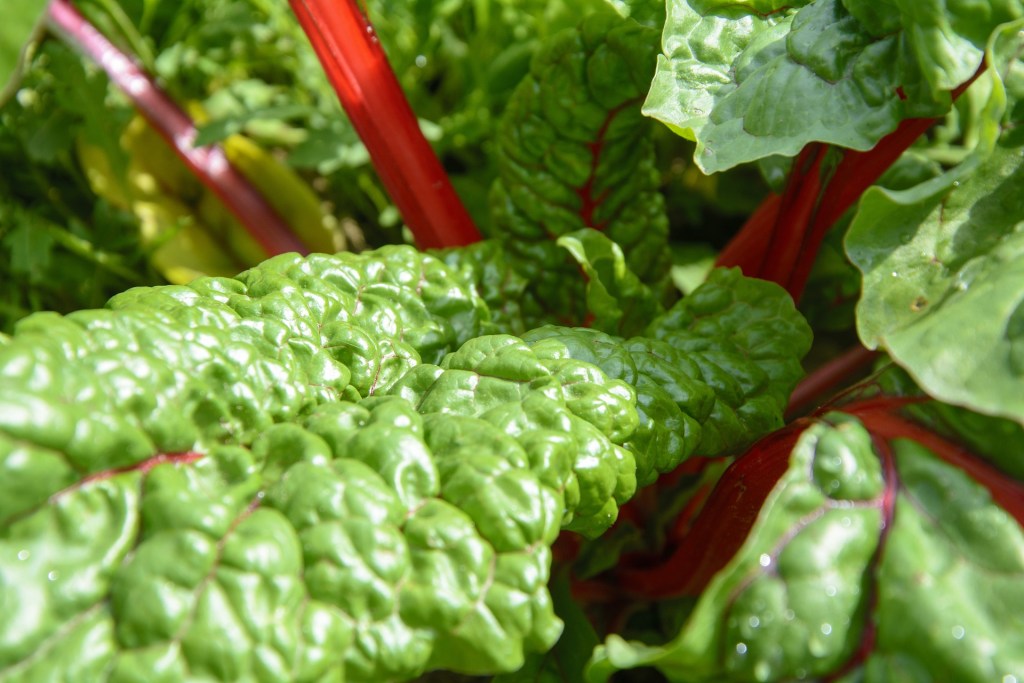The leaves of a Swiss chard plant are fabulously beautiful with their dark green color and brightly colored center veins. Not only are they pretty, but they’re incredibly good for you as well! Those of us with limited growing space do have to make hard choices about what we can grow, but Swiss chard is a great option for those of us looking to grow produce that’s both nutritious and beautiful.

Swiss chard care
Before we get into how you can grow delicious Swiss chard right in your kitchen, let’s first go over the things a Swiss chard plant needs to grow. This will help you eliminate spaces in your home where it won’t thrive and select a location and care routine to allow these colorful greens to flourish.
One of the most essential aspects of Swiss chard care is the amount of sunlight they need. This plant needs almost full sun all day long, and providing direct sunlight to an indoor plant all day can be difficult. That’s why we suggest placing it in the sunniest place in your home and supplementing shady hours with a grow light. While some grow lights aren’t too aesthetically pleasing, there are a few that can double as decor while still aiding your plant. If you don’t have a spot in your home with full sun, you can use a grow light as the plant’s sole light source, just be sure to put the plant under the grow light for at least six hours a day.
Swiss chard prefers its soil to be a bit on the acidic side of the pH scale. When you’re preparing your pot, be sure to mix in a balanced fertilizer so the plant will have plenty of nutrients. You’ll also want the soil to be well-draining; the plant roots might rot if the soil doesn’t drain well enough, and all those yummy leaves will be dead before you can enjoy them.
Although Swiss chard doesn’t need a deep container, since its roots don’t grow deep, it still needs plenty of space, so be sure to choose a container that’s at least 12 inches wide. Only one plant should be grown in a 12 inch pot. A 5 gallon bucket is a great option, but be sure you drill drainage holes into the bottom of it.
Once your Swiss chard is fully established, water when the soil dries out most of the way. You don’t have to worry about reapplying fertilizer unless you see signs of stress or lack of food from the plant.

How to plant Swiss chard indoors
Before you get all your supplies out, you’ll want to bring out your Swiss chard seeds and soak them in water for 24 hours before you plant them. This speeds up the germination process and will increase the likelihood of a successful planting. Once they’ve been soaking for 24 hours, you can get everything else ready.
Take your growing container and fill it with the well-draining soil you’ve chosen. Then, add the balanced fertilizer. Use a sieve or fine strainer and gather your soaked seeds. Plant the seeds half an inch deep, and don’t be afraid to put two in one spot, just in case one doesn’t germinate. Wet the soil enough so that it’s damp, but water isn’t running out the bottom.
Place the now-planted containers in their designated spot and set up your grow light station if needed. After about five days, you should start seeing little sprouts poking out of the soil. Wait a few weeks and see if you have more than one plant per hole. If you do, you can select the smaller plant and cut it at the soil to ensure the bigger plant has plenty of resources.
Once the plant is big and mature, you can begin to harvest the outer leaves as it grows. Leave the inner leaves to keep growing and maturing, and you’ll have fresh Swiss chard in your kitchen all season long!


